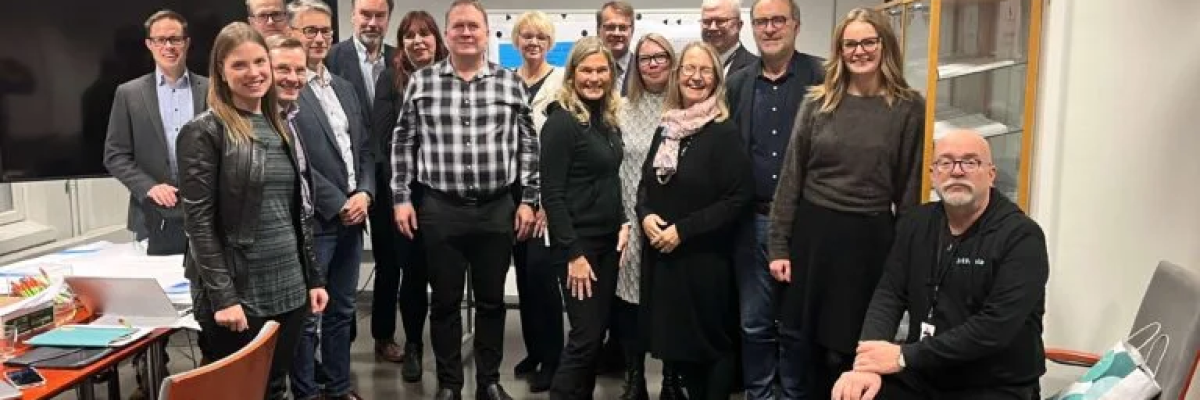
Successful project drives progress for hydrogen and innovation valleys
In Ostrobothnia, there are great opportunities to build both a successful Hydrogen Valley and a Regional Innovation Valley. A recently completed project has contributed to advancing both initiatives.
The project Innovation Valley Ostrobothnia was completed at the turn of the year. One of the goals of the project was to identify, seize opportunities, and build consensus around certain areas within the green transition where Ostrobothnia has strong potential for strengthening RDI-partnerships, regionally and across the EU.
“The project, for example, worked to create an understanding of what an Innovation Valley is and what it could mean for us,” says Kaisa Penttilä, who led the project headed by the Regional Council of Ostrobothnia.
An Innovation Valley is a status and a new EU instrument that can be used to increase the opportunities for funding innovation ecosystems. The instrument seeks to strengthen robust interconnected innovation ecosystems across regions and create favourable innovation environments at a regional level, supporting the scale-up of new solutions targeting EU’s key burning challenges, such as reducing reliance on fossil fuels.
Jumped straight into action
The nearly one year long project started at a time when many of the hydrogen activities in Ostrobothnia were at a critical stage.
“Much of the work quickly focused on how we could push forward to secure investments and create structures for exchanging knowledge in a broader group,” says Kaisa Penttilä.
The project succeeded in creating consensus with many other actors. Together with a number of key actors across four Finnish regions, and with the lead of Technology Centre Merinova in particular, the framework for a large Hydrogen Valley consortium was built, which also applied for funding.
“Unfortunately, the funding was not secured in this round, but the work continues. There is a task force group, and especially in the BotH2nia network, we are moving forward,” says Kaisa Penttilä, who now works for Vaasa University of Applied Sciences VAMK.
Larger area than expected achieved status
When it comes to securing the status of Regional Innovation Valley, the project succeeded even beyond expectations. It is now not just Ostrobothnia that has received the status, but all of Western Finland.
“Labels are important; through them, you enter European networks, and networking drives development,” says Kaisa Penttilä.
Niklas Ulfvens, Director of Regional Development at the Regional Council of Ostrobothnia, explains that now that the area has received the Innovation Valley status, various actors in the region, such as universities, can utilize it.
Four focus areas selected
Four focus areas have been selected where work will continue and intensify in different ways under the Regional Innovation Valley umbrella. Much of the work involves building R&D projects that, in turn, create new knowledge around these areas.
“The focus is on research and development activities, but these are activities that should be close to the market, for example piloting or demonstrating a new solution,” says Johanna Dahl, Regional Development Expert at the Regional Council of Ostrobothnia.
The four focus areas have been developed in close cooperation with the three subregions in Ostrobothnia and stem from identified needs, both from a business and regional development point of view.
The first focus area concerns increasing renewable energy production as well as energy storage, among other things. Hydrogen is a natural part of this and in this way, this aspect ties in nicely.
The second focus area deals with carbon-neutral logistics solutions. The third area focuses on building business innovation hubs around certain industrial areas. The fourth focus area concerns spearheading technology development and especially the involvement of small and medium-sized companies.
Johanna Dahl emphasizes that, whereas the overarching framework now is set, changes to the specific innovation actions under the focus areas may still occur, as the work is continuously progressing in dialogue with regional actors and potential international collaboration partners. A funding application and a new opportunity will open in May, so this will also contribute to concretizing the scope even further.
Has an international dimension
Niklas Ulfvens explains that one of the core ideas behind the entire project, both in terms of the Regional Innovation Valley part and the hydrogen valley, has been to initiate collaboration with different stakeholders.
“Now that the project is ending, we are extracting the different parts from the project. We will continue working on certain aspects while other actors will proceed with their work,” he says.
Niklas Ulfvens also highlights the international dimension of this, noting that the entire work gives the council a new platform and expanded international networks.
“The project was successful even from the perspective of having gained new working methods,” says Niklas Ulfvens.
Mats Brandt, Regional Mayor of Ostrobothnia, affirms that the now-concluded project fundamentally addresses the issue of how we can and should scale up R&D activities both qualitatively and quantitatively.
Photo: Participants and organizers of one of the Regional Innovation Valley Stakeholder Workshops. Front row: Kaisa Penttilä, Fredrik Sandelin, Niklas Ulfvens, John Dahlbacka, Sari Kola, Miia Lammi, Maria Backman, Philippe Vanrie, Johanna Dahl, Tauno Kekäle. Back row: Fredrik Hanstén, Mikko Helle, Pertti Miettunen, Marja-Riitta Vest, Angelique Irjala, Mika Grundström, Sören Mattbäck.
The original article was published in Vaasa International (23.1.2025). Author: Peter Stolpe